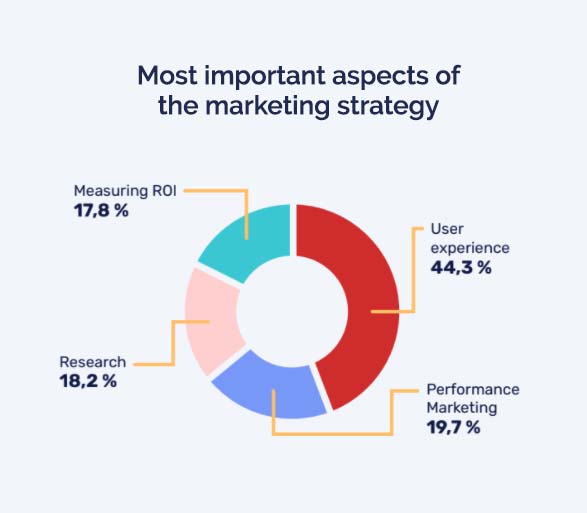Alfredo Perez, International Business Development Manager of Tiendeo01.13.22
2021 was a year of adjustments in which the economy slowly recovered from the outbreak of the Covid-19 epidemic, a year that many believed would mean a return to normalcy, but the new Omicron variant rocked the world once again as a fresh reminder that, no, Covid has not gone away yet.
What does the next twelve months have in store for us? In 2022, we will continue to reshape the world with one thing in mind: to build our new reality... A direction that major retailers and brands were already beginning to move towards by reorganizing their channels and resources.
Looking to the future, Alfredo Pérez, International Business Development Manager at Tiendeo, explains the trends and tools that will be used by retail sector leaders and professionals, derived from his Hot Retail Trends 2022 study*.
1. Increased focus on e-commerce and digital channels
Changes in shopping habits have led to the digital channel becoming the preferred means of connecting with consumers. According to statistics, digital marketing (83%), social networks (73%) and e-commerce (63%) are positioned as the most relevant media for marketers in Latin America. The leading role that e-commerce is playing in the region is evident, 7 points higher than the international average.
In fact, in pursuit of ensuring greater traceability of campaigns, content personalization and automation strategies, retailers and brands have opted to implement the digital transformation of the consumer industry, encouraging constant interaction with the customer in both online and offline channels, resulting in 57% of marketers favoring digital channels while 41% lean towards offline channels.

2. Long live social shopping!
With 64% of the world's population shopping via social media1, marketers are clear on where they are going to spend their advertising dollars. According to the Tiendeo study, 58% of retail executives will increase their advertising spend on social media in the next 12 months.
Although social shopping is a well established trend in other parts of the world, this year the retail sector in Latin America will exploit the benefits of social shopping to the fullest. Accenture estimates that by 2025 the largest volume of sales in this channel will be in clothing (18%), electronics (13%) and home (7%)..
3. Customer experience above all else
The main challenge facing retailers today is to identify the right time and channels to engage with both potential and repeat customers in order to offer them a seamless and frictionless shopping experience.
According to the Hot Retail Trends 2022 study, for 44% of marketing professionals, user experience is the most important aspect to consider in their strategy. Under this premise, retail is developing multi-touch strategies such as ROPO (Research Online and Purchase Offline) so that the consumer can have different alternatives and conversion points when shopping, whether on the web, e-commerce, or in the physical store.

4. More innovative stores
Digital mannequins that learn about your favorite items and guide you through the aisles, cashierless self-checkout stores, smart shelves that verify product availability or virtual try-on sessions, yes, these are the stores of the future.
Perez adds "With the incorporation of breakthrough technology (augmented reality, artificial intelligence, etc.) throughout the sales process, we will see increasingly autonomous stores that allow consumers to find what they are looking for almost instantly, receive the immediate attention they need, try it before buying it and also (why not) pay for it quickly, making a simple purchase a multi-sensory brand experience". Retailers such as Walmart and Carrefour have already taken the plunge into this new way of interacting with customers in order to compete with the e-commerce giants.
5. Focus on the circular economy
Customer concern for the environment has led retailers to reassess their strategies to be more environmentally conscious in order to find a balance between economic growth and sustainability. .
In sustainable practices such as the Circular Economy where production cycles are closed to make the most of natural resources, the role played by digital tools is key. In 2021 many retailers began to implement more sustainable marketing actions with the digitization of the promotional catalog, long considered the key to generating brand awareness. This type of model favors the reduction of industrial waste by up to 80%.
Thus, industry professionals will step up their investment in digital advertising to communicate with customers, and this year digital channels will account for 86% of budget allocations, while offline media (outdoor advertising, catalogs, etc.) will account for 14%.
*Study conducted in EMEA and LATAM based on the opinion of 358 directors and brand managers in the consumer sector in multiple categories (supermarkets, home, fashion, electronics, beauty, toys, DIY, pets, sports, health and travel) between November 8, 2021 and December 13, 2021.
What does the next twelve months have in store for us? In 2022, we will continue to reshape the world with one thing in mind: to build our new reality... A direction that major retailers and brands were already beginning to move towards by reorganizing their channels and resources.
Looking to the future, Alfredo Pérez, International Business Development Manager at Tiendeo, explains the trends and tools that will be used by retail sector leaders and professionals, derived from his Hot Retail Trends 2022 study*.
1. Increased focus on e-commerce and digital channels
Changes in shopping habits have led to the digital channel becoming the preferred means of connecting with consumers. According to statistics, digital marketing (83%), social networks (73%) and e-commerce (63%) are positioned as the most relevant media for marketers in Latin America. The leading role that e-commerce is playing in the region is evident, 7 points higher than the international average.
In fact, in pursuit of ensuring greater traceability of campaigns, content personalization and automation strategies, retailers and brands have opted to implement the digital transformation of the consumer industry, encouraging constant interaction with the customer in both online and offline channels, resulting in 57% of marketers favoring digital channels while 41% lean towards offline channels.

2. Long live social shopping!
With 64% of the world's population shopping via social media1, marketers are clear on where they are going to spend their advertising dollars. According to the Tiendeo study, 58% of retail executives will increase their advertising spend on social media in the next 12 months.
Although social shopping is a well established trend in other parts of the world, this year the retail sector in Latin America will exploit the benefits of social shopping to the fullest. Accenture estimates that by 2025 the largest volume of sales in this channel will be in clothing (18%), electronics (13%) and home (7%)..
3. Customer experience above all else
The main challenge facing retailers today is to identify the right time and channels to engage with both potential and repeat customers in order to offer them a seamless and frictionless shopping experience.
According to the Hot Retail Trends 2022 study, for 44% of marketing professionals, user experience is the most important aspect to consider in their strategy. Under this premise, retail is developing multi-touch strategies such as ROPO (Research Online and Purchase Offline) so that the consumer can have different alternatives and conversion points when shopping, whether on the web, e-commerce, or in the physical store.

4. More innovative stores
Digital mannequins that learn about your favorite items and guide you through the aisles, cashierless self-checkout stores, smart shelves that verify product availability or virtual try-on sessions, yes, these are the stores of the future.
Perez adds "With the incorporation of breakthrough technology (augmented reality, artificial intelligence, etc.) throughout the sales process, we will see increasingly autonomous stores that allow consumers to find what they are looking for almost instantly, receive the immediate attention they need, try it before buying it and also (why not) pay for it quickly, making a simple purchase a multi-sensory brand experience". Retailers such as Walmart and Carrefour have already taken the plunge into this new way of interacting with customers in order to compete with the e-commerce giants.
5. Focus on the circular economy
Customer concern for the environment has led retailers to reassess their strategies to be more environmentally conscious in order to find a balance between economic growth and sustainability. .
In sustainable practices such as the Circular Economy where production cycles are closed to make the most of natural resources, the role played by digital tools is key. In 2021 many retailers began to implement more sustainable marketing actions with the digitization of the promotional catalog, long considered the key to generating brand awareness. This type of model favors the reduction of industrial waste by up to 80%.
Thus, industry professionals will step up their investment in digital advertising to communicate with customers, and this year digital channels will account for 86% of budget allocations, while offline media (outdoor advertising, catalogs, etc.) will account for 14%.
*Study conducted in EMEA and LATAM based on the opinion of 358 directors and brand managers in the consumer sector in multiple categories (supermarkets, home, fashion, electronics, beauty, toys, DIY, pets, sports, health and travel) between November 8, 2021 and December 13, 2021.


